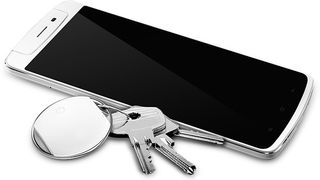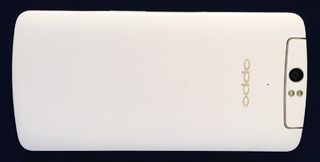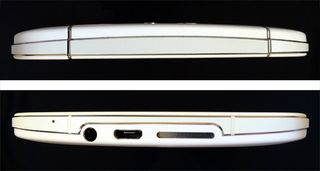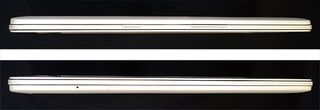Oppo N1 Review: Future-Looking Phablet Or Oversized Flop?
Oppo's N1 sports a unique pivoting camera, a large-format display, and two different operating system options. Are those features enough to make up for an older hardware platform and dicey software optimization in a sea of compelling competition?
Why you can trust Tom's Hardware
Look And Feel: Primarily Plastic, Positively Premium
To many folks, plastic is synonymous with cheap, and using it for the frame in a high-end device is a serious faux pas. While cost reduction is certainly one reason for choosing plastic, there’s another, more pertinent justification for considering the material in a phablet: weight. A structure made from plastic weighs roughly half as much as an aluminum equivalent. For a device such as a phone, which is meant to be easily carried all day, the emphasis on weight increases with size. When you consider that the N1 employs plastic on the front and back of the chassis, and still weighs in at 213 g (or nearly half a pound), the material choice makes sense. Even then, you're looking at 1.9 times the heft of the much smaller, but all-aluminum iPhone 5s.
Of course, there are other design factors to think about, such as durability, rigidity, and thermal conductivity. There, plastic is at a disadvantage to metal. Oppo’s solution is to add a solid aluminum frame around the perimeter of the N1, increasing both its strength and rigidity. The result is a phone that feels just as solid (with no discernible frame flex) as one made from all metal, but without the weight.

The melding of metal and plastic gives the N1 a premium feel that Oppo pairs with a sophisticated appearance. The matte white plastic has a smooth, ceramic-like texture that hides fingerprints well. The aluminum ring is also white, except for the chamfered, polished edges. Polished metal rings also surround the rotating camera module, camera lens, and LED flash.
The front of the N1, dominated by its 5.9” IPS LCD, is almost all Gorilla Glass 3. Normally, I don’t like white phones because I find the border distracting when viewing video, and ambiguous when reading text on a white background. Fortunately, this isn’t a problem for the N1. The white bezel on either side of the screen is so thin as to be nearly nonexistent. It blends into the slim lower bezel with nice compound radius corners. Only above the screen, where the camera module is located, is there any significant white to be seen. The display itself is surrounded by a black border that widens at the bottom where the three backlit, capacitive navigation buttons (menu, home, and back) are located. Centered above the screen is a speaker, which is only active during phone calls. To its right, you'll find an ambient light sensor for automatically adjusting the screen brightness and an infrared sensor that turns the screen off when the phone is held next to your face.
On the slightly curved back surface, printed in shiny chrome to match the polished metal edges, is the Oppo logo. Centered above that is a pinhole for the noise-canceling microphone. The camera lens and stacked, dual-LED flash reside within the rotating camera module.

The top edge is bereft of buttons or ports to make room for the rotating camera, while a pinhole microphone, microUSB port, and 3.5 mm headphone jack are located on the bottom. I like the idea of a front-facing speaker, or even better, front-facing stereo speakers on a phablet, since the larger screen makes watching video more enjoyable. Unfortunately, Oppo sticks with tradition and places a lone speaker on the bottom, where its output tends to get muffled by your hand.

On the left side, near the top, is the micro-SIM card port, while the right side is home to the power button (located just above center) and volume rocker switch (just below center). I find this arrangement to be very awkward when holding the phone in my right hand. My thumb can reach the power button easily enough with just a slight shift of hand position, but the volume rocker is so low that it’s basically off-limits for the same digit. Holding the N1 in landscape mode with one hand on each end of the phone, I really have to stretch to reach the volume rocker, since it’s so close to the centerline.

After nearly dropping the phone a few times while fiddling with the volume switch, I had an epiphany: I was holding it wrong! A phablet isn’t meant for single-handed use; it requires both hands for the full experience. And for a right-handed person, that means holding the phone in my left hand while navigating the screen with my right. Using the N1 in this manner, my fingers are perfectly perched above both the power button and volume rocker.
Current page: Look And Feel: Primarily Plastic, Positively Premium
Prev Page Oppo Dreams Big: The N1 Phablet Next Page Regarding The Phablet ExperienceStay on the Cutting Edge
Join the experts who read Tom's Hardware for the inside track on enthusiast PC tech news — and have for over 25 years. We'll send breaking news and in-depth reviews of CPUs, GPUs, AI, maker hardware and more straight to your inbox.
-
wavetrex Just a small comment about OLED, even if this might not be the place to write about it.Reply
Probably due to to imperfections in the transistors that control the OLED pixels, there is a very faint but perceptible in deep darkness leakage of energy toward the pixels.
Yes, doesn't compare to the obvious light bleed of any TFT display, but the OLED "off" pixels are not truly off, they have a 0.00something-small level of light which could theoretically be measured by some very sensitive equipment.
The eyes are certainly capable of seeing it... -
InvalidError Putting both flash LEDs on the same side so close to the image sensor seems like a missed opportunity to me: putting one LED close to each hinge with the camera in the middle would provide more even lighting and softer shadows.Reply
With the mostly passable image quality, that would not help the N1 much though. -
Onus Please don't put the letters "p" "h" "a" "b" "l" "e" "t" together in that order and treat it like a word.Reply
-
WyomingKnott @onusReply
First time I read the term I had the image of holding my 10" Asus pad up to my face and talking into it. I suppose it's better than a shoe; cleaner, too. -
shahbaz200 Bad GPU, doesn't works well on this device, poor performance, other than that its good device.Reply -
BlankInsanity please respect my opinion, but I don't see why phones need to go bigger. i the 90s phones used to be huge and this was a problem for mobility and so as the years went by they created smaller form factor phones. Now here we are repeating that mistake. A phone is ment to make a small footprint when hidden on it's user such as a pocket. You don't put your tablet in your pocket, I don't see why'd you make a phone out of it. this is just my opinionReply -
jankeke "please respect my opinion, but I don't see why phones need to go bigger. i the 90s phones used to be huge and this was a problem for mobility and so as the years went by they created smaller form factor phones. Now here we are repeating that mistake. A phone is ment to make a small footprint when hidden on it's user such as a pocket. You don't put your tablet in your pocket, I don't see why'd you make a phone out of it. this is just my opinion "Reply
True but people couldn't watch porn on their phones back then so it made sense to make them as small as possible. Not so now ... ^^ -
Matthew DiGiacomo No offense Tom's Hardware but why are you reviewing this phone now? It's outdated and been on the market for almost 8 months.. No one really cares about it anymore.Reply -
falchard The Camera is a smart solution meaning you won't need 2 cameras. Obviously it will need tilt support to tell it which direction is up.Reply
No removable battery is a shitty solution. Its the issue all phones face after 2 years, their batteries no longer hold a charge. -
BlankInsanity Reply13717317 said:The Camera is a smart solution meaning you won't need 2 cameras. Obviously it will need tilt support to tell it which direction is up.
No removable battery is a shitty solution. Its the issue all phones face after 2 years, their batteries no longer hold a charge.
lol that's a scam the companies do to force you to buy a new one ;)
